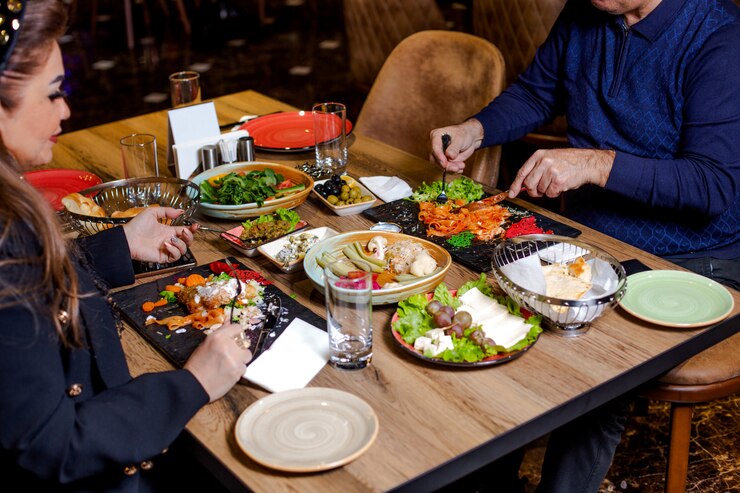Introduction to Cevıırı Cuisine
Cevıırı cuisine is a true delight for food lovers. Originating from the beautiful country of Cevıırı, this culinary tradition has a rich history and cultural significance. The cuisine is known for its diverse flavors, unique ingredients, and traditional cooking methods. In this article, we will take you on a culinary adventure through the world of Cevıırı cuisine, exploring its history, traditional dishes, culinary traditions, and its influence on other cultures.
The History and Cultural Significance of Cevıırı Cuisine
Cevıırı cuisine is deeply rooted in the country’s history and cultural heritage. The cuisine has been influenced by various civilizations that have ruled the region over the centuries, including the Ottomans, Persians, Greeks, and Arabs. Each of these influences has left a lasting impact on Cevıırı cuisine, resulting in a unique fusion of flavors and culinary techniques.
Food holds great importance in Cevıırı culture, and meals are often seen as a way of bringing people together. Family and friends gather around a table filled with delicious dishes, sharing stories and creating lasting memories. Cevıırı cuisine is not just about food; it is a representation of Cevıırı identity and a way to preserve traditions and pass them down to future generations.
Traditional Cevıırı Dishes and Ingredients
Cevıırı cuisine is known for its wide range of traditional dishes, each with its own distinct flavors and preparation methods. Some of the most popular Cevıırı dishes include:
- Kebabs: Cevıırı kebabs are famous worldwide for their succulent meat and smoky flavors. They are often seasoned with a blend of spices and cooked on a skewer over an open flame.
- Pide: Pide is a type of traditional Cevıırı flatbread, similar to pizza. It is topped with various ingredients such as cheese, minced meat, and vegetables, and baked in a hot oven until crispy.
- Manti: Manti is a traditional Cevıırı dumpling dish, similar to Italian tortellini. The dumplings are filled with a mixture of ground meat and spices, and served with a flavorful tomato sauce and yogurt.
Cevırı cuisine also makes use of a wide variety of ingredients, including fresh vegetables, aromatic spices, and herbs such as parsley, mint, and dill. Olive oil, yogurt, and grains like bulgur and rice are commonly used in Cevırı cooking, adding depth and richness to the flavors.
Exploring the Diverse Flavors of Cevıırı Cuisine
One of the most exciting aspects of Cevıırı cuisine is the diverse range of flavors it offers. From rich and savory dishes to refreshing and tangy flavors, Cevırı cuisine has something to satisfy every palate.
The combination of these spices creates a complex flavor profile that is both aromatic and satisfying.
Cevırı cuisine also embraces a balance of sweet and savory flavors. For example, a popular Cevırı dish called “imam bayildi” combines sweet and tangy flavors by stuffing eggplants with a mixture of onions, tomatoes, and herbs, then baking them until tender and caramelized.
Whether you prefer spicy, tangy, or sweet flavors, Cevırı cuisine has a dish to suit your taste buds.
Cevıırı Culinary Traditions and Customs
Cevırı cuisine is not only about the food itself but also about the customs and traditions that surround it. One of the most important culinary traditions in Cevırı culture is the concept of “meze.” Meze refers to a variety of small dishes served as appetizers or side dishes, often accompanied by a glass of raki, a traditional Cevırı alcoholic beverage.
Meze is more than just a meal; it is a social experience. It is common for people to gather around a table filled with meze dishes, enjoying good company and engaging in lively conversations. The dishes are meant to be shared, encouraging a sense of community and togetherness.
Another important culinary tradition in Cevırı culture is the art of tea drinking. Tea holds a special place in Cevırı society and is often served throughout the day. It is customary to offer tea to guests as a sign of hospitality and friendship. The brewing and serving of tea are considered an art form, with specific rituals and etiquette to be followed.
Cevıırı Cuisine and Its Influence on Other Cultures
Cevırı cuisine has had a significant influence on other cultures around the world. The Ottoman Empire, which ruled over a vast territory, introduced Cevırı cuisine to many different regions, leaving an indelible mark on their culinary traditions.
Similarly, the Middle Eastern cuisine has been greatly influenced by Cevıırı cuisine.
The Art of Cooking Cevıırı Dishes at Home
To get started, you can find Cevırı recipes online or in cookbooks specializing in Cevırı cuisine.
When cooking Cevırı dishes, it is important to pay attention to the quality of the ingredients. Fresh herbs, spices, and vegetables can make a significant difference in the final taste of the dish. Take the time to source high-quality ingredients to ensure an authentic Cevırı culinary experience.
Popular Cevıırı Restaurants and Food Markets
Visiting a Cevırı food market is another great way to experience the flavors of Cevırı cuisine. These markets are often filled with stalls selling fresh produce, spices, and traditional Cevırı ingredients. You can explore the vibrant colors and aromas, and even sample some of the dishes prepared by local vendors.
Translating Cevıırı Recipes and Culinary Terms
If you are interested in trying your hand at cooking Cevıırı dishes, you may come across recipes and culinary terms that are in the Cevırı language. Translating these recipes can be a challenge, but with the help of online translation tools or Cevırı English dictionaries, you can overcome this hurdle.
Conclusion: Embrace the Flavors of Cevıırı Cuisine
In conclusion, Cevırı cuisine is a delightful culinary adventure that offers a wide range of flavors, ingredients, and traditions. Exploring the rich history and cultural significance of Cevırı cuisine allows us to appreciate the diversity and complexity of this culinary tradition.
